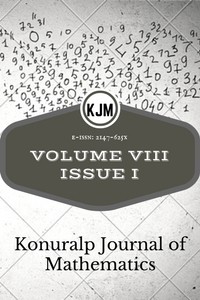Research Article
Year 2020,
Volume: 8 Issue: 1, 207 - 210, 15.04.2020
Abstract
References
- [1] J.S. Connor, On strong matrix summability with respect to a modulus and statistical convergence, Canad. Math. Bull. 32 (1989), 194-198.
- [2] H. Fast, Sur la convergence statistique, Colloq. Math. 2 (1951), 241–244.
- [3] E. Kolk, On strong boundedness and summability with respect to a sequence of moduli, TartuUl. Toimetised, 960 (1993), 41-50.
- [4] P. Kostyrko, T. Salat, W. Wilczynski, I-Convergence, Real Anal. Exchange, 26(2) (2000), 669–686.
- [5] V. Kumar, A. Sharma, Asymptotically lacunary equivalent sequences defined by ideals and modulus function, Mathematical Sciences, 6(23) (2012), 5 pages.
- [6] G. Lorentz, A contribution to the theory of divergent sequences, Acta Math. 80 (1948), 167–190.
- [7] I. J. Maddox, Sequence spaces defined by a modulus, Math. Proc. Camb. Phil. Soc. 100 (1986), 161–166.
- [8] M. Marouf, Asymptotic equivalence and summability, Int. J. Math. Math. Sci. 16(4) (1993), 755-762.
- [9] M. Mursaleen, O. H. H. Edely, On the invariant mean and statistical convergence, Appl. Math. Lett. 22 (2009), 1700–1704.
- [10] M. Mursaleen, Matrix transformation between some new sequence spaces, Houston J. Math. 9 (1983), 505–509.
- [11] M. Mursaleen, On finite matrices and invariant means, Indian J. Pure and Appl. Math. 10 (1979), 457–460.
- [12] H. Nakano, Concave modulars, J. Math. Soc. Japan, 5 (1953), 29-49.
- [13] F. Nuray, E. Savas¸, Invariant statistical convergence and A-invariant statistical convergence, Indian J. Pure Appl. Math. 10 (1994), 267–274.
- [14] F. Nuray, H. G¨ok, U. Ulusu, Is -convergence, Math. Commun. 16 (2011), 531–538.
- [15] N. Pancaroˇglu, F. Nuray, Statistical lacunary invariant summability, Theoretical Mathematics and Applications, 3(2) (2013), 71–78.
- [16] R. F. Patterson, On asymptotically statistically equivalent sequences, Demostratio Mathematica, 36(1) (2003), 149–153.
- [17] S. Pehlivan, B. Fisher, Some sequences spaces defined by a modulus, Mathematica Slovaca, 45 (1995), 275-280.
- [18] R. A. Raimi, Invariant means and invariant matrix methods of summability, Duke Math. J. 30 (1963), 81–94.
- [19] E. Savas¸, Some sequence spaces involving invariant means, Indian J. Math. 31 (1989), 1–8.
- [20] E. Savas¸, Strong s-convergent sequences, Bull. Calcutta Math. 81 (1989), 295–300.
- [21] E. Savas¸, F. Nuray, On s-statistically convergence and lacunary s-statistically convergence, Math. Slovaca, 43(3) (1993), 309–315.
- [22] P. Schaefer, Infinite matrices and invariant means, Proc. Amer. Math. Soc. 36 (1972), 104–110.
- [23] I. J. Schoenberg, The integrability of certain functions and related summability methods, Amer. Math. Monthly, 66 (1959), 361–375.
- [24] U. Ulusu, Asymptotoically ideal invariant equivalence, Creat. Math. Inform. 27 (2018), 215-220.
Year 2020,
Volume: 8 Issue: 1, 207 - 210, 15.04.2020
Abstract
In this study, we present the notions of strongly asymptotically $\mathcal{I}$-invariant equivalence, $f$-asymptotically $\mathcal{I}$-invariant equivalence, strongly $f$-asymptotically $\mathcal{I}$-invariant equivalence and asymptotically $\mathcal{I}$-invariant statistical equivalence for real sequences. Also, we investigate some relationships among them.
Keywords
Ideal Asymptotically equivalence $\mathcal{I}$-equivalence Invariant equivalence Modulus function
References
- [1] J.S. Connor, On strong matrix summability with respect to a modulus and statistical convergence, Canad. Math. Bull. 32 (1989), 194-198.
- [2] H. Fast, Sur la convergence statistique, Colloq. Math. 2 (1951), 241–244.
- [3] E. Kolk, On strong boundedness and summability with respect to a sequence of moduli, TartuUl. Toimetised, 960 (1993), 41-50.
- [4] P. Kostyrko, T. Salat, W. Wilczynski, I-Convergence, Real Anal. Exchange, 26(2) (2000), 669–686.
- [5] V. Kumar, A. Sharma, Asymptotically lacunary equivalent sequences defined by ideals and modulus function, Mathematical Sciences, 6(23) (2012), 5 pages.
- [6] G. Lorentz, A contribution to the theory of divergent sequences, Acta Math. 80 (1948), 167–190.
- [7] I. J. Maddox, Sequence spaces defined by a modulus, Math. Proc. Camb. Phil. Soc. 100 (1986), 161–166.
- [8] M. Marouf, Asymptotic equivalence and summability, Int. J. Math. Math. Sci. 16(4) (1993), 755-762.
- [9] M. Mursaleen, O. H. H. Edely, On the invariant mean and statistical convergence, Appl. Math. Lett. 22 (2009), 1700–1704.
- [10] M. Mursaleen, Matrix transformation between some new sequence spaces, Houston J. Math. 9 (1983), 505–509.
- [11] M. Mursaleen, On finite matrices and invariant means, Indian J. Pure and Appl. Math. 10 (1979), 457–460.
- [12] H. Nakano, Concave modulars, J. Math. Soc. Japan, 5 (1953), 29-49.
- [13] F. Nuray, E. Savas¸, Invariant statistical convergence and A-invariant statistical convergence, Indian J. Pure Appl. Math. 10 (1994), 267–274.
- [14] F. Nuray, H. G¨ok, U. Ulusu, Is -convergence, Math. Commun. 16 (2011), 531–538.
- [15] N. Pancaroˇglu, F. Nuray, Statistical lacunary invariant summability, Theoretical Mathematics and Applications, 3(2) (2013), 71–78.
- [16] R. F. Patterson, On asymptotically statistically equivalent sequences, Demostratio Mathematica, 36(1) (2003), 149–153.
- [17] S. Pehlivan, B. Fisher, Some sequences spaces defined by a modulus, Mathematica Slovaca, 45 (1995), 275-280.
- [18] R. A. Raimi, Invariant means and invariant matrix methods of summability, Duke Math. J. 30 (1963), 81–94.
- [19] E. Savas¸, Some sequence spaces involving invariant means, Indian J. Math. 31 (1989), 1–8.
- [20] E. Savas¸, Strong s-convergent sequences, Bull. Calcutta Math. 81 (1989), 295–300.
- [21] E. Savas¸, F. Nuray, On s-statistically convergence and lacunary s-statistically convergence, Math. Slovaca, 43(3) (1993), 309–315.
- [22] P. Schaefer, Infinite matrices and invariant means, Proc. Amer. Math. Soc. 36 (1972), 104–110.
- [23] I. J. Schoenberg, The integrability of certain functions and related summability methods, Amer. Math. Monthly, 66 (1959), 361–375.
- [24] U. Ulusu, Asymptotoically ideal invariant equivalence, Creat. Math. Inform. 27 (2018), 215-220.
There are 24 citations in total.
Details
| Primary Language | English |
|---|---|
| Subjects | Engineering |
| Journal Section | Articles |
| Authors | |
| Publication Date | April 15, 2020 |
| Submission Date | March 26, 2020 |
| Acceptance Date | April 11, 2020 |
| Published in Issue | Year 2020 Volume: 8 Issue: 1 |
Cite

The published articles in KJM are licensed under a Creative Commons Attribution-NonCommercial 4.0 International License.


